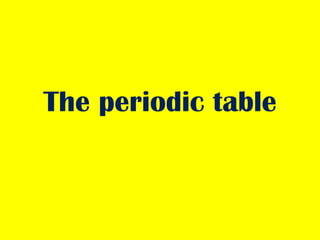
The essential guide to the periodic table
- 2. What is the periodic table ? • The periodic table is a table of the chemical elements in which the elements are arranged by order of atomic number in such a way that the periodic properties (chemical periodicity) of the elements are made clear.
- 4. What does the periodic table include? The standard form of the table includes periods (usually horizontal in the periodic table) and groups (usually vertical). Elements in groups have some similar properties to each other. There is no one single or best structure for the periodic table but by whatever consensus there is, the form used here is very useful. The periodic table is a masterpiece of organised chemical information.
- 5. The history of the periodic table The history of the periodic table reflects over a century of growth in the understanding of chemical properties. The most important event was the publication of the first periodic table by Dmitri Mendeleev in 1869.While Mendeleev built upon earlier discoveries by such scientists as AntoineLaurent de Lavoisier and Stanislao Cannizzaro, the Russian scientist is generally given sole credit for development of the periodic table.
- 6. Antoine-Laurent de Lavoisier Lavoisier's Traité Élémentaire de Chimie (Elementary Treatise of Chemistry, 1789, translated into English by Robert Kerr) is considered to be the first modern chemical textbook. It contained a list of elements, or substances that could not be broken down further, which included oxygen, nitrogen, hydrogen, ph osphorus,mercury, zinc, and sulfur. It also forms the basis for the modern list of elements. His list, however, also included light and caloric, which he believed to be material substances.
- 7. Johann Wolfgang Döbereiner In 1817, Johann Wolfgang Döbereiner began to formulate one of the earliest attempts to classify the elements. In 1828 he found that some elements formed groups of three with related properties. He termed these groups "triads". Some triads classified by Döbereiner are: chlorine, bromine, and iodine calcium, strontium, and barium sulfur, selenium, and tellurium lithium, sodium, and potassium In all of the triads, the atomic mass of the second element was almost exactly the average of the atomic weights of the first and third elements
- 8. John Newlands J. A. R. Newlands' law of octaves John Newlands was an English chemist who in 1865 classified the 56 elements that had been discovered at the time into eleven groups which were based on similar physical properties.
- 9. Dmitri Mendeleev • Dmitri Mendeleev, a Russian chemist, was the first scientist to make a periodic table much like the one we use today. Mendeleev arranged the elements in a table ordered by atomic mass, corresponding to relative molar mass as defined today. It is sometimes said that he played "chemical solitaire" on long train journeys using cards with various facts of known elements. • Shortcomings of Mendeleev's table His table did not include any of the noble gases, which were discovered later. These were added by Sir William Ramsay as Group 0, without any disturbance to the basic concept of the periodic table. A single position could not be assigned to hydrogen in the periodic table. Hydrogen could be placed in the alkali metals group as well as in the halogens group.
- 10. How to find group and period of an element 1. Do the electron configuration 2. If it ends with s p,it belongs to the group A. 3. If it ends with s d, it belongs to the group B. 4. If it ends with f, it belongs to the B group. 5. The number of group is find by summing the nr. of electrons. 6. The period is the biggest quantum number.
- 11. Curiosity Element 117 discovered? A paper just published (5 April 2010) in Physical Review Letters by Yu. Ts. Oganessian and others claims the synthesis of a new element with atomic number 117. The abstract states "The discovery of a new chemical element with atomic number Z=117 is reported. The isotopes 293117 and 294117 were produced in fusion reactions between 48Ca and 249Bk. Decay chains involving eleven new nuclei were identified by means of the Dubna Gas Filled Recoil Separator. The measured decay properties show a strong rise of stability for heavier isotopes with Z>=111, validating the concept of the long sought island of enhanced stability for super-heavy nuclei."
